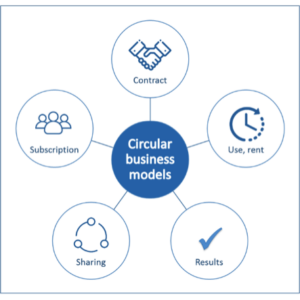Designing products to be durable and repairable could mean customers replace them less frequently and so our annual sales may drop. Even charging more for a better quality product might not offset that reduced revenue.
We need to develop new value streams and find other business benefits – perhaps we can sell spare parts, maintenance and repair services, and even upgrades ? To capture value from circular economy approaches, we need to deploy different business models, focusing on access instead of ownership.

Characteristic of circular models
Typical circular business models include :
- Contracts with added services, like cars: with a fixed monthly fee that includes servicing, for an agreedmileage
- ‘Use’ or rental, for example bike and car hire
- Subscription services, already common for streaming services like music, and useful for products with a short use-cycle, such as Rent the Runway for ‘special occasion’ fashion
- Payment by Results (’performance’), such as Philips ‘pay per lux’ lighting, and Chemicals as a Service
- ‘Peer to Peer’ Sharing includes Airbnb and community tool libraries (if a business owns the assets, it’s really a rental or subscription model).
So what value opportunities might spring from retaining ownership of the product?
- At end-of-use, we can recover key parts and materials, and find out how well it’s performed and withstood wear and tear.
- We can resell our recovered products, perhaps after refurbishment or even remanufacturing. That can open up new markets, providing a cheaper remanufactured version (with the same warranty as a new one) for customers who can’t afford the new product.
- Rather than a big marketing spend to acquire new customers, we’ve built a much closer relationship with our existing customers. We’ve engaged with them about new products and services, and found out how to serve them.
- Providing access and higher levels of product utilisation could ‘touch’ many more customers. BMW’s Drive Now service provides ‘on demand’ cars, with potential for hundreds of customers for each car, instead of one customer per car under the ‘ownership’ model.

